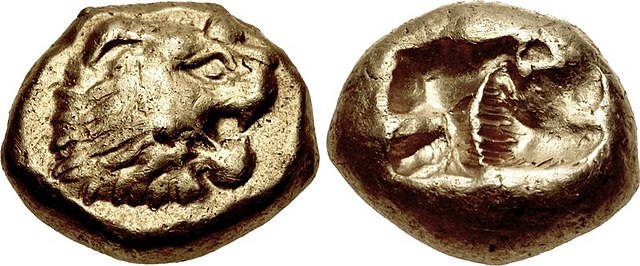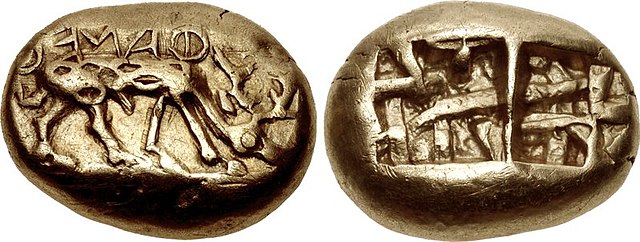The obverse and reverse are the two flat faces of coins and some other two-sided objects, including paper money, flags, seals, medals, drawings, old master prints and other works of art, and printed fabrics. In this usage, obverse means the front face of the object and reverse means the back face. The obverse of a coin is commonly called heads, because it often depicts the head of a prominent person, and the reverse tails.
Roman imperial coin, struck c. 241, with the head of Tranquillina on the obverse, or front of the coin, and her marriage to Gordian III depicted on the reverse, or back side of the coin, in smaller scale; the coin exhibits the obverse – "head", or front – and reverse – "tail", or back – convention that still dominates much coinage today. Legend: SABINIA TRANQVILLINA AVG / CONCORDIA AVGG.
A Roman imperial coin of Marcus Claudius Tacitus, who ruled briefly from 275 to 276, follows the convention of obverse and reverse coin traditions. Legend: IMP C M CL TACITVS AVG / VICTORIA GOTTHI
Obverse of the tetradrachm of Alexander the Great, intended to be seen as a deity, wearing the attributes of the hero, Heracles/Hercules. 325 BC.
Solidus of Justinian II after 705. Christ is on the obverse (left), the emperor on the reverse. Legend: D[OMI]N[US] IHS[US] CH[RI]S[TOS] REX RAGNANTIUM / D[OMI]N[US] IUSTINIANUS MULTUS A[ΝΝΙ].
A coin is a small object, usually round and flat, used primarily as a medium of exchange or legal tender. They are standardized in weight, and produced in large quantities at a mint in order to facilitate trade. They are most often issued by a government. Coins often have images, numerals, or text on them. The faces of coins or medals are sometimes called the obverse and the reverse, referring to the front and back sides, respectively. The obverse of a coin is commonly called heads, because it often depicts the head of a prominent person, and the reverse is known as tails.
A selection of metal coins
An oxhide ingot from Crete. Late Bronze Age metal ingots were given standard shapes, such as the shape of an "ox-hide", suggesting that they represented standardized values.
Coin of Alyattes of Lydia, c. 620/10–564/53 BC
The earliest inscribed coinage: electrum coin of Phanes from Ephesus, 625–600 BC. Obverse: Stag grazing right, ΦΑΝΕΩΣ (retrograde). Reverse: Two incuse punches, each with raised intersecting lines.




![Solidus of Justinian II after 705. Christ is on the obverse (left), the emperor on the reverse. Legend: D[OMI]N[US] IHS[US] CH[RI]S[TOS] REX RAGNANTIU](https://upload.wikimedia.org/wikipedia/commons/thumb/e/e2/Solidus-Justinian_II-Christ_b-sb1413.jpg/640px-Solidus-Justinian_II-Christ_b-sb1413.jpg)



